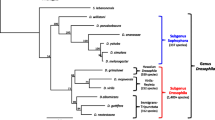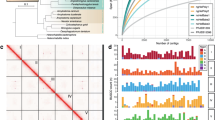Abstract
Genes involved in the recognition of parasites by the acquired immune system are often subject to intense selection pressures. In some cases, selection to recognize a diverse range of parasites has resulted in high levels of polymorphism, while elsewhere the protein sequence has changed rapidly under directional selection. We tested whether parasite recognition genes in the innate immune system show similar patterns of evolution. We sequenced seven peptidoglycan recognition protein genes (PGRPs) from 12 lines of Drosophila melanogaster and one line of D. simulans and used a variety of tests to determine whether the observed mutations were selectively neutral. We were unable to detect either balancing or directional selection. This suggests that the molecular cues used by insects to detect parasites are highly conserved and probably under strong functional constraints which prevent their evolving to evade the host immune response. Therefore, interactions between these genes are unlikely to be the focus of host–parasite coevolution, at least in Drosophila. We also found evidence of gene conversion occurring between two genes, PGRP-SC1A and PGRP-SC1B.



Similar content being viewed by others
References
MD Adams SE Celniker RA Holt et al. (2000) ArticleTitleThe genome sequence of Drosophila melanogaster. Science 287 2185–2195 Occurrence Handle10.1126/science.287.5461.2185 Occurrence Handle10731132
N Arnheim (1983) Concerted evolution of multigene families. M Nei RK Koehn (Eds) Evolution of genes and proteins. Sinauer Associates Sunderland, MA 33–61
HJ Carius TJ Little D Ebert (2001) ArticleTitleGenetic variation in a host-parasite association: Potential for coevolution and frequency-dependent selection. Evolution 55 1136–1145 Occurrence Handle1:STN:280:DC%2BD38%2FisFWhsg%3D%3D Occurrence Handle11475049
KM Choe T Werner S Stoven D Hultmark KV Anderson (2002) ArticleTitleRequirement for a peptidoglycan recognition protein (PGRP) in relish activation and antibacterial immune responses in Drosophila. Science 296 359–362 Occurrence Handle10.1126/science.1070216 Occurrence Handle1:CAS:528:DC%2BD38XjtVWhu7g%3D Occurrence Handle11872802
GK Christophides E Zdobnov C Barillas-Mury et al. (2002) ArticleTitleImmunity-related genes and gene families in Anopheles gambiae. Science 298 159–165 Occurrence Handle10.1126/science.1077136 Occurrence Handle1:CAS:528:DC%2BD38XnsFSgsr0%3D Occurrence Handle12364793
AG Clark L Wang (1997) ArticleTitleMolecular population genetics of Drosophila immune system genes. Genetics 147 713–724 Occurrence Handle1:CAS:528:DyaK2sXmslOqs7g%3D Occurrence Handle9335607
A Date Y Satta N Takahata SI Chigusa (1998) ArticleTitleEvolutionary history and mechanism of the Drosophila cecropin gene family. Immunogenetics 47 417–429 Occurrence Handle10.1007/s002510050379 Occurrence Handle1:CAS:528:DyaK1cXit1akt7o%3D Occurrence Handle9553148
E De Gregorio PT Spellman GM Rubin B Lemaitre (2001) ArticleTitleGenome-wide analysis of the Drosophila immune response by using oligonucleotide microarrays. Proc Natl Acad Sci USA 98 12590–12595 Occurrence Handle10.1073/pnas.221458698 Occurrence Handle1:CAS:528:DC%2BD3MXotFaiuro%3D Occurrence Handle11606746
PC Doherty RM Zinkernagel (1975) ArticleTitleEnhanced immunologic surveillance in mice heterozygous at the H-2 gene complex. Nature 256 50–52 Occurrence Handle1:STN:280:CSqC2srivVw%3D Occurrence Handle1079575
Y-X Fu W-H Li (1993) ArticleTitleStatistical tests of neutrality of mutations. Genetics 133 693–709 Occurrence Handle1:STN:280:ByyB3c3kvVU%3D Occurrence Handle8454210
M Gottar V Gobert T Michel M Belvin G Duyk JA Hoffmann D Ferrandon J Royet (2002) ArticleTitleThe Drosophila immune response against Gram-negative bacteria is mediated by a peptidoglycan recognition protein. Nature 416 640–644 Occurrence Handle10.1038/nature734 Occurrence Handle1:CAS:528:DC%2BD38XjtFams7k%3D Occurrence Handle11912488
NGd Groot N Otting GGM Doxiadis SS Balla-Jhagjhoorsingh JL Heeney JJv Rood P Gagneux RE Bontrop (2002) ArticleTitleEvidence for an ancient selective sweep in the MHC class I gene repertoire of chimpanzees. Proc Natl Acad Sci USA 99 11748–11753 Occurrence Handle10.1073/pnas.182420799 Occurrence Handle12186979
RR Hudson M Kreitman M Aquade (1987) ArticleTitleA test of neutral molecular evolution based on nucleotide data. Genetics 116 153–159 Occurrence Handle1:CAS:528:DyaL2sXktlCgsLk%3D Occurrence Handle3110004
AL Hughes M Nei (1988) ArticleTitlePattern of neucleotide substitution at major histocompatibility complex Class-I loci reveals overdominant selection. Nature 335 167–170 Occurrence Handle3412472
AL Hughes M Yeager (1997) ArticleTitleCoordinated amino acid changes in the evolution of mammalian defensins. J Mol Evol 44 675–682 Occurrence Handle1:CAS:528:DyaK2sXjslKjurs%3D Occurrence Handle9169560
P Irving L Troxler TS Heuer M Belvin C Kopczynski JM Reichhart JA Hoffmann C Hetru (2001) ArticleTitleA genome-wide analysis of immune responses in Drosophila. Proc Natl Acad Sci USA 98 15119–15124 Occurrence Handle10.1073/pnas.261573998 Occurrence Handle1:CAS:528:DC%2BD38XpsVWg Occurrence Handle11742098
DH Janzen (1980) ArticleTitleWhen is it coevolution? Evolution 34 611–612
BP Lazzaro AC Clark (2001) ArticleTitleEvidence for recurrent paralogous gene conversion and exceptional allelic divergence in the Attacin genes of Drosophila melanogaster. Genetics 159 659–671 Occurrence Handle1:CAS:528:DC%2BD3MXot1Srs78%3D Occurrence Handle11606542
W-H Li (1997) Molecular evolution. Sinauer Associates Sunderland MA
JH McDonald M Kreitman (1991) ArticleTitleAdaptive protein evolution at the Adh locus in Drosophila. Nature 351 652–654 Occurrence Handle1:CAS:528:DyaK3MXks1yrtLs%3D Occurrence Handle1904993
R Medzhitov CA Janeway (1997) ArticleTitleInnate immunity: The virtues of a nonclonal system of recognition. Cell 91 295–298 Occurrence Handle1:CAS:528:DyaK2sXnt1Clsrw%3D Occurrence Handle9363937
P Mellroth J Karlsson H Steiner (2003) ArticleTitleA scavenger function for Drosophila peptidoglycan recognition protein. J Biol Chem 278 7059–7064 Occurrence Handle10.1074/jbc.M208900200 Occurrence Handle1:CAS:528:DC%2BD3sXhsVKis7w%3D Occurrence Handle12496260
T Michel JM Reichhart JA Hoffmann J Royet (2001) ArticleTitle Drosophila Toll is activated by Gram-positive bacteria through a circulating peptidoglycan recognition protein. Nature 414 756–759 Occurrence Handle10.1038/414756a Occurrence Handle1:CAS:528:DC%2BD38XhtlyjsA%3D%3D Occurrence Handle11742401
EN Moriyama JR Powell (1996) ArticleTitleIntraspecific nuclear DNA variation in Drosophila. Mol Biol Evol 13 261–277 Occurrence Handle1:CAS:528:DyaK28XhtVylu7k%3D Occurrence Handle8583899
M Nei (1987) Molecular evolutionary genetics. Columbia University Press New York
O Niare K Markianos J Volz F Oduol A Toure M Bagayoko D Sangare SF Traore R Wang C Blass G Dolo M Bouare FC Kafatos L Kruglyak YT Toure KD Vernick (2002) ArticleTitleGenetic loci affecting resistance to human malaria parasites in a West African mosquito vector population. Science 298 213–216 Occurrence Handle10.1126/science.1073420 Occurrence Handle1:CAS:528:DC%2BD38XnsFSgs7o%3D Occurrence Handle12364806
M Ramet P Manfruelli A Pearson B Mathey-Prevot RAB Ezekowitz (2002) ArticleTitleFunctional genomic analysis of phagocytosis and identification of a Drosophila receptor for E. coli. Nature 416 644–648 Occurrence Handle10.1038/nature735 Occurrence Handle1:CAS:528:DC%2BD38XjtFams7Y%3D Occurrence Handle11912489
S Ramos-Onsins M Aguade (1998) ArticleTitleMolecular evolution of the Cecropin multigene family in Drosophila: Functional genes vs. pseudogenes. Genetics 150 157–171 Occurrence Handle1:CAS:528:DyaK1cXmtFKgsr8%3D Occurrence Handle9725836
C Su M Nei (1999) ArticleTitleFifty-million-year-old polymorphism at an immunoglobulin variable region gene locus in the rabbit evolutionary lineage. Proc Natl Acad Sci USA 96 9710–9715 Occurrence Handle10.1073/pnas.96.17.9710 Occurrence Handle1:CAS:528:DyaK1MXlsVymtrg%3D Occurrence Handle10449759
F Tajima (1989) ArticleTitleStatistical method for testing the neutral mutation hypothesis by DNA polymorphism. Genetics 123 585–595 Occurrence Handle1:CAS:528:DyaK3cXhslentA%3D%3D Occurrence Handle2513255
T Tanaka M Nei (1989) ArticleTitlePositive Darwinian selection observed at the variable-region genes of immunoglobulins. Mol Biol Evol 6 447–459 Occurrence Handle1:CAS:528:DyaL1MXlslahs7Y%3D Occurrence Handle2796726
GA Watterson (1975) ArticleTitleOn the number of segregating sites in models without recombination. Theor Pop Biol 7 256–276 Occurrence Handle1:STN:280:CSqC1MbgvF0%3D
T Werner G Liu D Kang S Ekengren H Steiner D Hultmark (2000) ArticleTitleA family of peptidoglycan recognition proteins in the fruit fly Drosophila melanogaster. Proc Natl Acad Sci USA 97 13772–13777 Occurrence Handle10.1073/pnas.97.25.13772 Occurrence Handle1:CAS:528:DC%2BD3cXoslyns70%3D Occurrence Handle11106397
H Yoshida K Kinoshita M Ashida (1996) ArticleTitlePurification of a peptidoglycan recognition protein from hemolymph of the silkworm, Bombyx mori. J Biol Chem 271 13854–13860 Occurrence Handle1:CAS:528:DyaK28XjsVOjsL0%3D Occurrence Handle8662762
XJ Zhou T Nguyen DA Kimbrell (1997) ArticleTitleIdentification and characterization of the Cecropin antibacterial protein gene locus in Drosophila virilis. J Mol Evol 44 272–281 Occurrence Handle1:CAS:528:DyaK2sXhs1Glsrc%3D Occurrence Handle9060393
Acknowledgements
We wish to thank Dr. John Brookfield for supplying Drosophila lines and two anonymous reviewers for helpful comments. F.M.J. is funded by a Research Fellowship from Emmanuel College, Cambridge, and a Natural Environment Research Council small grant. G.D.D.H. is supported by a Biotechnology and Biological Sciences Research Council D. Phillips Fellowship.
Author information
Authors and Affiliations
Corresponding author
Rights and permissions
About this article
Cite this article
Jiggins, F.M., Hurst, G.D. The Evolution of Parasite Recognition Genes in the Innate Immune System: Purifying Selection on Drosophila melanogaster Peptidoglycan Recognition Proteins . J Mol Evol 57, 598–605 (2003). https://doi.org/10.1007/s00239-003-2506-6
Received:
Accepted:
Issue Date:
DOI: https://doi.org/10.1007/s00239-003-2506-6




